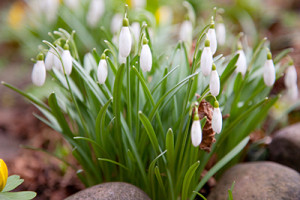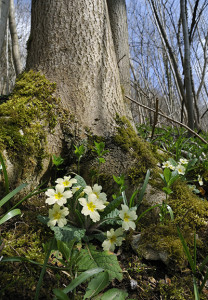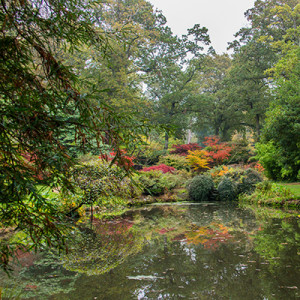 As I pondered a topic for this month, a friend suggested “spring fashions” and here’s what happened: 1) I decided fellow Risky Isobel’s expertise on Regency fashions so far exceeds my own, I should leave that topic to her, and 2) I started to suffer an almost rabid craving for spring in England. Is anyone else feeling it?
As I pondered a topic for this month, a friend suggested “spring fashions” and here’s what happened: 1) I decided fellow Risky Isobel’s expertise on Regency fashions so far exceeds my own, I should leave that topic to her, and 2) I started to suffer an almost rabid craving for spring in England. Is anyone else feeling it?
Spring comes earlier to England, at least to much of it, than it does to my own location in New England, in the U.S. I recall vividly my surprise to discover snowdrops blooming in London in January the first time I ever crossed the pond. This month, March, is when I usually begin to look for them here, and not this early in March, either, despite the very mild weather we’ve recently had here.
 But, oh, in England! March is a month for daffodils and other spring flowers we are only still wishing for where I live. Here the green tips are only just beginning to show in the gardens. I found some potted primroses in my local market and had to buy them, even though they are already fading. This tiny watercolor by E. Daniels (it’s only 2 inches by 2 ¼ inches) graces a shelf in my office, a beloved souvenir from a past trip to England that gives me primroses year-round.
But, oh, in England! March is a month for daffodils and other spring flowers we are only still wishing for where I live. Here the green tips are only just beginning to show in the gardens. I found some potted primroses in my local market and had to buy them, even though they are already fading. This tiny watercolor by E. Daniels (it’s only 2 inches by 2 ¼ inches) graces a shelf in my office, a beloved souvenir from a past trip to England that gives me primroses year-round.
In The Winter’s Tale, Shakespeare wrote: “Daffodils/That come before the swallow dares, and take/ The winds of March with beauty”. This image has lasted through the centuries. The seasons and nature offer a wonderful bridge between us and the past. The same kind of March winds that Shakespeare mentioned are roaring outside my windows today as I write this, even if I haven’t yet any nodding daffodils. These kinds of seasonal details help us as storytellers trying to make our historical fiction feel real. We need those threads of common experience that transcend the centuries to help anchor our characters and plots!
Several of my books are set in  late spring, or at least begin then. In my first one, A Perilous Journey, I took a little liberty to have my characters find late-blooming daffodils even though it was May, but at least they were in the north on their way to Scotland…. I’ve always loved the playful cover created by artist Alan Kass for the original (OP) Signet edition of that book. (It is only available now from Penguin Intermix as an ebook.)
late spring, or at least begin then. In my first one, A Perilous Journey, I took a little liberty to have my characters find late-blooming daffodils even though it was May, but at least they were in the north on their way to Scotland…. I’ve always loved the playful cover created by artist Alan Kass for the original (OP) Signet edition of that book. (It is only available now from Penguin Intermix as an ebook.)
The arrival of spring, when it finally does come here, probably won’t cure my craving for England (I am sooooo overdue for a visit!). However, it will help. In the meantime, I’ll go out and check the forsythia to see if it has started to bud. I’ll bring some branches inside to “force” into bloom and tide me over while I wait! I’m certain that’s something a Regency heroine might do, if I ever start a story in March. But not with forsythia, and not because it would already be blooming. It wasn’t introduced in England until after the Regency. A Regency heroine would have to use flowering quince, or pear, apple, or cherry branches from the orchard, or lilacs, or mock orange or….hmm, more research required. Perhaps she’ll just pick some daffodils!!
 Where do you like to ferret out what would be blooming when in your stories? Or, what sources do you love to go back to for inspiration, not necessarily information? My favorites for inspiration include both the Country Diary and the Nature Notes of an Edwardian Lady (Edith Holden), even though these are not from our period. For sheer visual inspiration, I’m currently enjoying a lovely book called The Writer’s Garden: How Gardens Inspired Our Best-Loved Authors, by Jackie Bennett with photography by Richard Hanson. A picture book that visits the homes and gardens of 19 authors, starting with Jane Austen at Godmersham and Chawton, it is a visual treat and a delightful way to travel by armchair! I highly recommend it, especially if you’re craving spring and it hasn’t come yet where you are!!
Where do you like to ferret out what would be blooming when in your stories? Or, what sources do you love to go back to for inspiration, not necessarily information? My favorites for inspiration include both the Country Diary and the Nature Notes of an Edwardian Lady (Edith Holden), even though these are not from our period. For sheer visual inspiration, I’m currently enjoying a lovely book called The Writer’s Garden: How Gardens Inspired Our Best-Loved Authors, by Jackie Bennett with photography by Richard Hanson. A picture book that visits the homes and gardens of 19 authors, starting with Jane Austen at Godmersham and Chawton, it is a visual treat and a delightful way to travel by armchair! I highly recommend it, especially if you’re craving spring and it hasn’t come yet where you are!!



